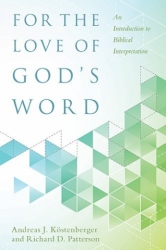What we want from those who would help us interpret and understand Scripture rightly is a widely and deeply informed heart and mind that is submissive to God’s Word and devoted to the pursuit of truth. That’s a tall order, but Andreas Köstenberger and Richard Patterson fit the bill, as their 2011 Invitation to Biblical Interpretation famously demonstrates. Their new For the Love of God’s Word: An Introduction to Biblical Interpretation now promises to be an important textbook in hermeneutics also, and we are very pleased to talk to Dr. Köstenberger today about their work.
Books At a Glance (Fred Zaspel):
For the Love of God’s Word is an abridgment of your earlier work, Invitation to Biblical Interpretation. Besides the reduced size, how do these works differ? And what are your respective audiences in view in each?
Köstenberger:
 Invitation to Biblical Interpretation, at over 800 pages, was addressed primarily to a seminary audience. We’ve had many requests to boil down the material to the core essentials, and this is what For the Love of God’s Word is designed to do, in about 350 pages. We’ve written this book primarily for college students, and even upper-level high school and homeschool students, as well as pastors, elders, and other serious Bible students who want to be thoroughly equipped to interpret God’s word according to each biblical genre.
Invitation to Biblical Interpretation, at over 800 pages, was addressed primarily to a seminary audience. We’ve had many requests to boil down the material to the core essentials, and this is what For the Love of God’s Word is designed to do, in about 350 pages. We’ve written this book primarily for college students, and even upper-level high school and homeschool students, as well as pastors, elders, and other serious Bible students who want to be thoroughly equipped to interpret God’s word according to each biblical genre.
Books At a Glance:
What is the “hermeneutical triad” that features so prominently in your book? How is this approach important for us in understanding the Bible?
Köstenberger:
The “hermeneutical triad” encompasses the three major dimensions of the study of the biblical text: its historical background, literary context, and theological message. When we interpret Scripture, we are confronted with three realities: the reality of history, the reality of the text, and the reality of God. The three parts of the hermeneutical triad are designed to do justice to these three realities and to result in a balanced, full-orbed interpretation that grasps and engages the three primary dimensions of each passage.
Books At a Glance:
Summarize for us, then, the layout of your book and how readers can expect to progress through it.
Köstenberger:
We start out with an introductory chapter introducing our readers to the hermeneutical triad. After this, we embark on our interpretive journey by first investigating the historical dimension of the text (especially biblical chronology and archeology). This is followed by a canonical survey of both Testaments, based on the premise that to interpret the parts of Scripture, we need to have a sense of the storyline of Scripture as a whole. After this, we traverse through the various biblical genres: OT historical narrative, wisdom literature, prophecy, NT historical narrative (Gospels and Acts), epistles, and apocalyptic (Revelation). We also cover breaking down a passage into its constituent parts and discerning word meanings (word study). We conclude the book with a chapter on biblical theology and a chapter on application.
Books At a Glance:
Are there other features about this book that you hope will distinguish it among textbooks on hermeneutics?
Köstenberger:
We believe the hermeneutical triad will resonate with many readers who look for a simple yet fully adequate way of interpreting Scripture. In particular, we believe the biblical-theological approach underlying our entire volume will be deeply satisfying for evangelical, gospel-centered readers who seek the Scriptures primarily for a word from God for their lives. Some other books move from general to special hermeneutics on the premise that we ought to interpret the Bible like any other book. While we agree that there is an overlap, we move from special to general hermeneutics, because we affirm that biblical interpretation requires a spiritual interpreter. Also, we don’t just focus on rules, or steps, or methods, of biblical interpretation but seek to develop virtuous interpreters who grow in interpretive skills such as canonical consciousness, historical awareness, sensitivity to genre, and other interpretive virtues.
Books At a Glance:
I found your opening emphasis on authorial intent and the “ethical dimension” of interpretation to be both helpful and refreshing. Could you summarize your point here for us and explain how it is important as we approach Scripture?
Köstenberger:
We argue that authors have important rights, in particular that their words and texts be interpreted in keeping with their communicative intent. This introduces an important ethical dimension into interpretation that is violated by those today who say that the interpreter’s experience or individual readings are determinative for textual meaning. For this reason, interpreters must take a conscious step to submit to the authority of Scripture, that is, the message intended by the human biblical author and ultimately by God himself and the Holy Spirit who inspired Scripture.
Books At a Glance:
How do the “academic” skills of the interpreter relate to the spiritual and moral qualifications that are demanded of him or her? How does our own intellectual effort relate to the work of the Spirit in this task of interpretation?
Köstenberger:
As I mentioned, one of the distinctive features of this book is our underlying conviction that the interpretation of Scripture requires a spiritual, virtuous interpreter. This involves the recognition that interpreting Scripture is different from interpreting any other book because Scripture is divinely inspired, authoritative, and revelatory. This is why we, in distinction from most other comparable works, move from special to general interpretation, that is, from the canon of Scripture and its various genres to discourse analysis and word study. In the words of the psalmist, in Scripture “deep calls to deep”; that is, the Bible is addressed to those who are hungry and thirsty for God’s Word, who acknowledge their dependence on the guidance of the Holy Spirit in interpretation, in short, those who love God’s Word and are prepared to obey it – hence the title For the Love of God’s Word.
Books At a Glance:
I would love to talk to you further about each section of your book, not least the final chapter on how to apply Scripture rightly to ourselves. But we’ll leave it here. Thanks so much for an excellent guide to understanding the greatest book in all the world.
Do you have any other books in the making that we can look for in the near future?
Köstenberger:
Thanks for asking. In September, Crossway will release The First Days of Jesus: The Story of the Incarnation, a prequel to The Final Days of Jesus. This is a biblical-theological study of the birth narratives in Matthew and Luke and John’s prologue in the context of Old Testament messianic predictions, intended as a tool to deepen our celebration of Christmas.
In January of next year, Women in the Church will appear in a third edition from Crossway.
Then, in May, B&H Academic is slated to publish Going Deeper with New Testament Greek, an intermediate textbook. I’m very grateful to these publishers for their continued commitment to excellence in academic publishing.
Buy the books

FOR THE LOVE OF GOD'S WORD: AN INTRODUCTION TO BIBLICAL HERMENEUTICS
